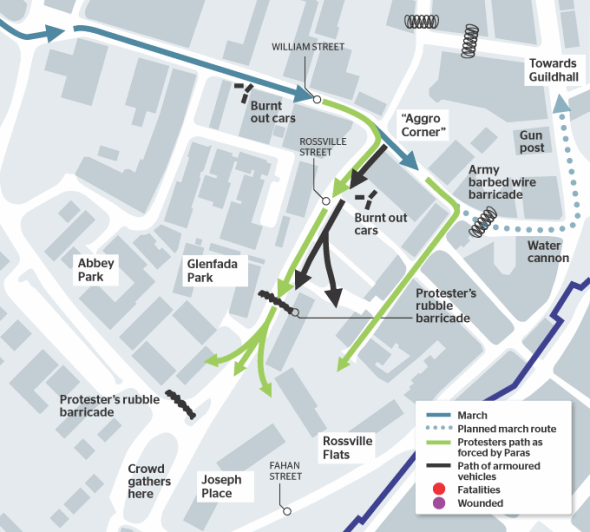Judge condemns Bloody Sunday troops
Lord Saville’s key conclusions
Lord Saville finds the army to blame for the events of Bloody Sunday in his report on the tragic events of January 1972
- The commanding officer of the paratroopers, Lieutenant Colonel Derek Wilford, disobeyed an order from a superior officer not to enter troops into the nationalist Bogside estate;
- Brigadier Patrick MacLellan, Col Wilford’s superior officer, held no blame for the shootings as if he had known what Col Wilford was intending, he might well have called it off;
- The commander of land forces in Northern Ireland, Major General Robert Ford, would have been aware that the Parachute Regiment had a reputation for using excessive force. But he would not have believed there was a risk of paratroopers firing unjustifiably;
- No blame was placed on the organisers of the march, the Northern Ireland Civil Rights Association;
- Neither the UK nor Northern Ireland governments planned or foresaw the use of unnecessary lethal force;
- “On balance” the first shot in the vicinity of the march was fired by British soldiers. In no case was any warning given by the soldiers before opening fire;
- The bloodshed is blamed on troops from the support company “losing their self-control ... forgetting or ignoring their instructions and training”. The result was a “serious and widespread loss of fire discipline”;
- None of the casualties was carrying a firearm, and while there was some shooting by republican paramilitaries, “none of this firing provided any justification for the shooting of civilian casualties”;
- Some of those who were killed or injured were clearly fleeing or going to the assistance of others who were dying;
- No-one threw, or threatened to throw, nail or petrol bombs at soldiers. “Despite the contrary evidence given by soldiers, we have concluded that none of them fired in response to attacks or threatened attacks by nail or petrol bombers”;
- The accounts of soldiers were rejected, with a number said to have “knowingly put forward false accounts”;
- Members of the official IRA fired a number of shots, though it was concluded it was the paratroopers who shot first;
- Northern Ireland Deputy First Minister Martin McGuinness, second in command of the provisional IRA in Derry in 1972, was “probably armed with a Thompson submachine gun”, and though it is possible he fired the weapon, this cannot be proved. The report concluded: “He did not engage in any activity that provided any of the soldiers with any justification for opening fire.”
|

